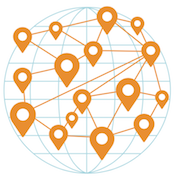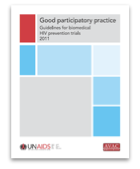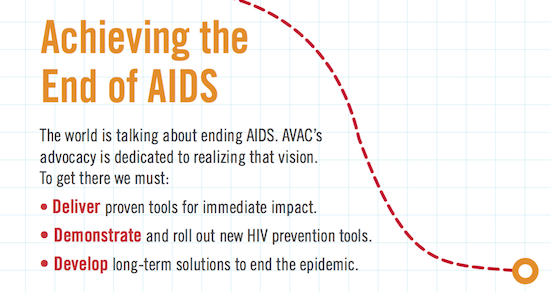Contacts
AVAC: Kay Marshall, [email protected], +1-347-249-6375
IAVI: Rose Catlos, [email protected], +1-212-847-1049
New York and Paris —
A new report released today ahead of the 9th IAS Conference on HIV Science documents 2016 funding and highlights a continuing trend of flat or declining funding and its potential impact on further innovation in HIV prevention research and development (R&D).
The Resource Tracking for HIV Prevention R&D Working Group’s (RTWG) 13th annual report, HIV Prevention Research & Development Investments, 2016: Investment priorities to fund innovation in a challenging global health landscape, documents the lowest annual investment in HIV prevention R&D in more than a decade. In 2016, funding for HIV prevention R&D decreased by three percent (US$35 million) from the previous year, falling to US$1.17 billion.
At a time when the field is moving towards a new slate of efficacy trials across the prevention pipeline and follow-on research for successful antiretroviral-based prevention options is underway or planned this trend is worrisome, particularly in light of uncertainties around the sustainability of public sector support from the US and other funders. Even small declines in funding can delay or sideline promising new HIV prevention options that are needed to end the HIV epidemic.
The US continued to be the major funder of HIV prevention research. In fact, 88 cents of every dollar spent on HIV prevention R&D in 2016, came from just two donors: the US public sector and the Bill & Melinda Gates Foundation. In contrast, European public sector funding fell by US$10 million from 2015, and at US$59 million, accounted for just six percent of all public sector investment. This is the lowest European funding recorded in the last decade and marks a 52 percent decrease from the peak funding (US$124 million) in 2009. In addition, the number of philanthropic donors fell sharply from a total of 27 in 2015 to just 12 in 2016.
The RTWG renewed a call for a greater range of donors to increase the stability of R&D financing and cushion potential impact if any of the major funders were to reduce their investments. Noting increases in public sector funding from the Netherlands and Sweden, the RTWG called on other European countries to increase investment in critical HIV prevention tools to help end the epidemic.
The past year has seen one new HIV vaccine efficacy trial begin and another planned to begin later in 2017; a novel proof-of-concept trial of antibody-mediated prevention underway; a monthly vaginal ring with the antiretroviral (ARV) drug dapivirine proven effective and under review by the European Medicines Agency; a multipurpose technology combining dapivirine and a contraceptive has launched early-stage trials; a long-acting ARV-based injectable PrEP formulation is beginning efficacy trials; and, finally, daily oral PrEP delivery programs are being scaled up in multiple countries. And behind these more advanced R&D activities come many other different HIV prevention modalities poised to prove themselves in early-stage research.
“The latest figures from UNAIDS show us that there has been progress toward meeting the 90 90 90 treatment goals, but there has been less progress – and less reporting – on meeting the prevention goals that are critical to epidemic control,” said Mitchell Warren, AVAC executive director. “We need to not only vastly accelerate roll out of HIV treatment and existing prevention options, we need continued and sustained investment to keep HIV prevention research on track to provide the new tools that will move the world closer to ending AIDS.”
The RTWG has tracked more than US$17 billion in investment towards biomedical HIV prevention since 2000 and warned that the greatest impact of this investment could be lost without continued and sustained support to move promising prevention options from laboratories and clinics into the lives of those who most need them.
“We are at an incredibly exciting time in the field of HIV prevention research and development with more life saving innovations, science and technology coming to the forefront than ever before,” said Luiz Loures, Deputy Executive Director of UNAIDS. “We cannot allow a lack of funding to set back progress. Invest now and we can end AIDS by 2030.”
The report documents some critical increases in funding, including the highest annual investment in preventive HIV vaccines since 2007, which includes the highest investment by the US public sector in preventive vaccine research since 2000, in part because of the start of the first vaccine efficacy trial in almost a decade. Yet European public sector investment in vaccine research was the lowest since 2001. The increase in support for vaccine research comes at a critical time in vaccine R&D and is an example of funders responding to the need for investment to keep promising research moving forward. The RTWG noted this level of investment should be occurring across the field to support the broadest possible pipeline of promising new HIV prevention options.
“A true end to AIDS will only be possible if we can develop and deploy an effective HIV vaccine and other innovative biomedical products for HIV prevention” said Mark Feinberg, President and CEO of the International AIDS Vaccine Initiative (IAVI). “With growing risk of increasing rates of HIV infection due to demographic trends and incomplete reach of HIV treatment programs, advances being made in HIV R&D needs support and acceleration. Progress can only happen with sustained public and private sector investment in HIV prevention R&D.”
The HIV field comes together in Paris next week at IAS2017 at a time when there is both much to be optimistic about in HIV science and in the accumulated knowledge of what and how we need to deliver treatment, prevention and care to the people who need it most. Yet, as the title of the report notes, this optimism faces a volatile global health landscape. Funding constraints, policy changes, shifting donor priorities and shifting demographics will all play a role in the world’s ability to respond to the continued challenges that HIV presents.
“After years of prudent and increasingly high-impact investment in HIV prevention and treatment, we have seen amazing dividends in lives saved, families kept together, communities revitalized and economies boosted,” added Warren. “We cannot lose that momentum. We have the innovative science. Now we need an expanded cadre of innovative funders who will work with us to ensure a continued return on investment in more lives saved and more infections averted.”
The report and infographics on prevention research investment are online at www.hivresourcetracking.org and on social media with #HIVPxinvestment.
###
Since 2000, the Resource Tracking for HIV Prevention R&D Working Group (formerly the HIV Vaccines & Microbicides Resource Tracking Working Group) has employed a comprehensive methodology to track trends in research and development (R&D) investments and expenditures for biomedical HIV prevention options. AVAC leads the secretariat of the Working Group, that also includes the International AIDS Vaccine Initiative (IAVI) and the Joint United Nations Programme on HIV/AIDS (UNAIDS). This year’s report is additionally made possible by the support of several donors, including the Bill & Melinda Gates Foundation and the American people through the US President’s Emergency Plan for AIDS Relief (PEPFAR) and the US Agency for International Development (USAID). The contents are the responsibility of AVAC and the Working Group and do not necessarily reflect the views of PEPFAR, USAID or the United States Government.















